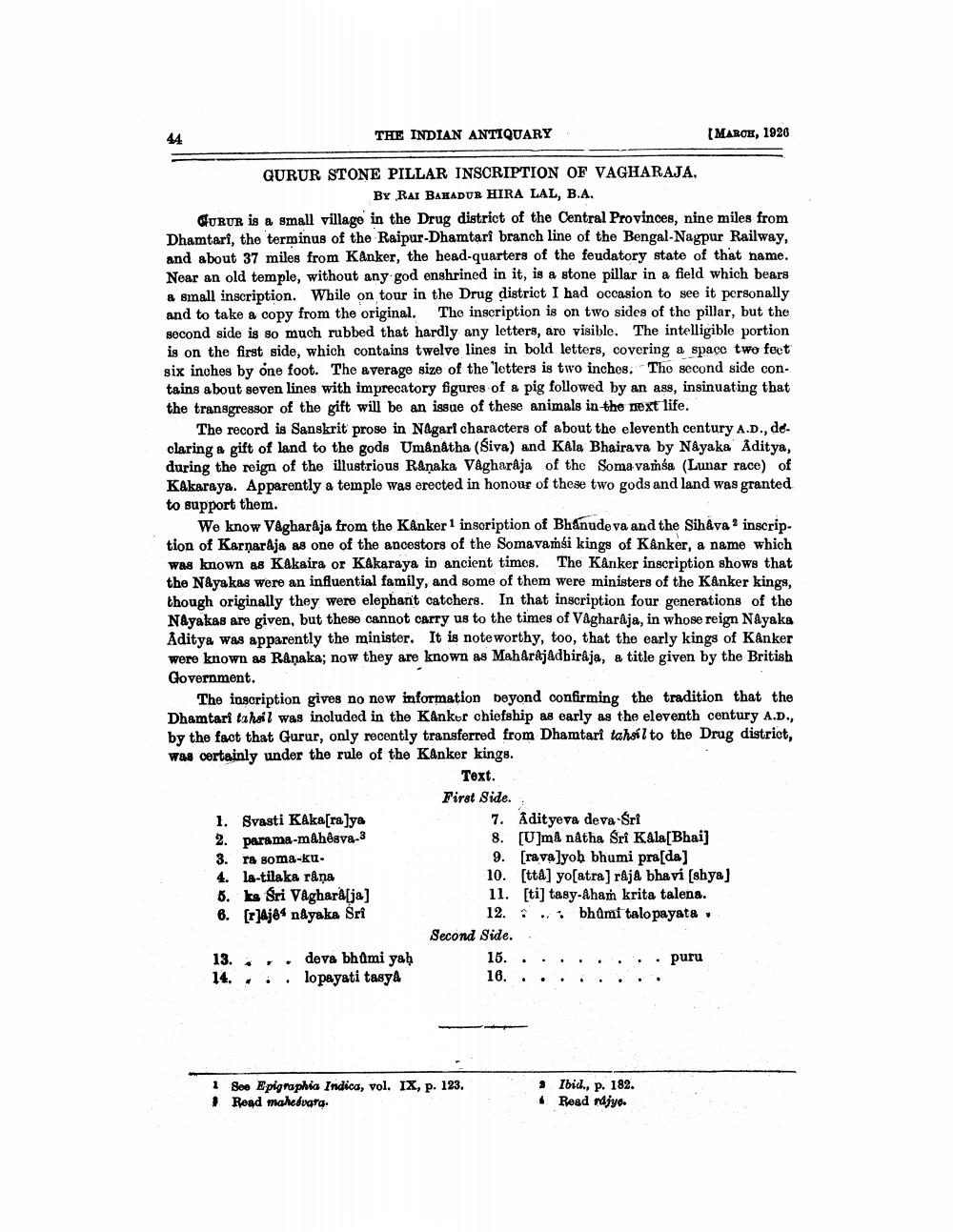________________
THE INDIAN ANTIQUARY
(MAROH, 1926
QURUR STONE PILLAR INSCRIPTION OF VAGHARAJA.
BY RAI BAHADUR HIRA LAL, B.A. CURUB is a small village in the Drug district of the Central Provinces, nine miles from Dhamtari, the terminus of the Raipur-Dhamtari branch line of the Bengal-Nagpur Railway. and about 37 miles from Kanker, the head-quarters of the feudatory state of that name. Near an old temple, without any god enshrined in it, is a stone pillar in a field which bears a small inscription. While on tour in the Drug district I had occasion to see it personally and to take a copy from the original. The inscription is on two sides of the pillar, but the second side is so much rubbed that hardly any letters, are visible. The intelligible portion is on the first side, which contains twelve lines in bold letters, covering a space two feet six inches by one foot. The average size of the letters is two inches. The second side contains about seven lines with imprecatory figures of a pig followed by an ass, insinuating that the transgressor of the gift will be an issue of these animals in the next life.
The record is Sanskrit prose in Nagari characters of about the eleventh century A.D., declaring a gift of land to the gods Umanatha (Siva) and Kala Bhairava by Nayaka Aditya, during the reign of the illustrious Ranaka Vågharaja of the Soma vamsa (Lunar race) of KAkaraya. Apparently a temple was erected in honour of these two gods and land was granted to support them.
We know Vaghardja from the Kanker 1 inscription of Bhanude va and the Siháva ? inscription of Karnardja as one of the ancestors of the Somavamới kings of Kanker, a name which was known as Kakaira or Kakaraya in ancient times. The Kanker inscription shows that the Nayakas were an influential family, and some of them were ministers of the Kanker kings, though originally they were elephant catchers. In that inscription four generations of the Nyakas are given, but these cannot carry us to the times of Vagharája, in whose reign Nayaka Aditya was apparently the minister. It is noteworthy, too, that the early kings of Kanker were known as Ranaka; now they are known as Maharajadbiraja, a title given by the British Government.
The inscription gives no now information beyond confirming the tradition that the Dhamtari tahsil was included in the Kankur chiefship as early as the eleventh century A.D., by the fact that Gurur, only recently transferred from Dhamtari tahsil to the Drug district, was certainly under the rule of the Kanker kings.
Text.
First Side 1. Svasti Kaka[ra]ya
7. Adityeva deva Sri 2. parama-mahêsva 3
8. [U]må nátha Sri Kala [Bhai] 3. ra soma-ku.
9. [rava]yob bhumi pra[da] 4. la-tilaka råņa
10. [tta] yo[atra) raja bhavi (shya] 8. ks Sri Vaghara[ja]
11. [ti) tasy-Ahaṁ krita talena. 6. [r]Aj84 nayaka Sri
12... bhdmi talo payata
Second Side. 13. , deva bhdmi yah
15......... puru 14. i lopayati tasya
16. .. . .. ..
1 Soe Epigraphia Indica, vol. IX, p. 123. ! Read mahedvara.
; .
Ibid., p. 182. Read ndjye.




